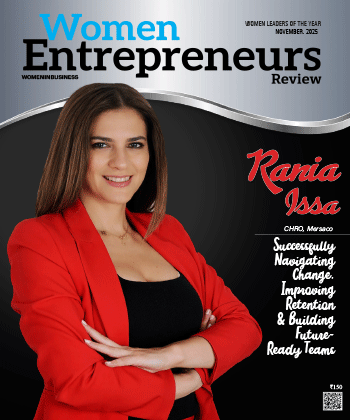
Embracing Diversity for Enhanced Muti-Generational Leadership Growth
By: Jyotsana Saxena, Chief People Officer Cluster India & Indian Subcontinent, DB Schenker
Jyotsana is a seasoned Human Resources professional with over 20 years of experience. She excels in driving transformative strategies, shaping organizational cultures, and nurturing talent development across diverse industries. Her commitment to continuous learning and innovation has significantly contributed to the success of esteemed organizations throughout her career.
In a recent conversation with Women Entrepreneurs Review, Jyotsana emphasizes the critical need for organizations to foster learning-driven ecosystems to build future leadership pipelines in today's dynamic market landscape. With hybrid work and digital transformation on the rise, companies must leverage continuous learning as a strategic tool for agile and relevant leadership development amidst rapid disruption.
How do you see the current market landscape influencing the urgency for organizations to create learning-driven ecosystems, particularly when it comes to building future leadership pipelines?
The market is changing rapidly, often faster than we can keep up. We are experiencing disruptions from new technologies, shifting workforces, and increasing competition. Companies are adopting digital tools to enhance their operations and improve customer experiences. Customers now expect more transparency, personalization, and accountability. Recent global events, such as COVID-19, geopolitical tensions, and economic instability, have revealed weaknesses in supply chains and operational resilience. Many companies are now prioritizing employee health and well-being, offering flexible work arrangements and remote working models, and creating policies that help employees feel connected to the organizational culture. The transition to remote and hybrid work has also transformed team dynamics and communication.
To navigate this changing landscape, we need to develop leaders who are not only agile, innovative, and skilled in technology and data but should be able to collaborate effectively, prioritize diversity, equity, and inclusion, and build trust within their teams. Today's leaders must drive change and help others adapt to new situations and clearly communicate their vision and business priorities. The role of leaders in today’s world is highly dynamic, and we rely on them to realize our organization’s vision.
We recognize the pressing need to cultivate our leaders to navigate today’s complex challenges, drive innovation, and build a resilient workforce. In our organization, we offer formal trainings, mentorship, coaching, leadership development programs, global learning programs, challenging projects, opportunities for short-term roles to provide aligned exposure and networking opportunities such as events and conferences for peer learning’s. Additionally, we strive to foster a culture that values continuous learning and innovation, empowering employees to take charge of their own development.
With the rise of hybrid work and digital transformation, how can companies leverage continuous learning as a strategic tool for leadership development in a more decentralized and dynamic environment?
Hybrid work and digital transformation are now the new normal. In our industry, hybrid work models and remote working are emerging trends but have their own challenges of implementation. Digital transformation is also happening at a rapid pace. Considering the evolving work environment and flexible workplaces, we need leaders who can inspire our people to out-perform while working in a collaborative culture. To develop such leaders, we leverage continuous learning as a strategic tool for leadership development by adopting a flexible and integrated approach.
In a hybrid and remote working environment, digital learning solutions are crucial. They facilitation-demand access to virtual courses and bite-sized learning through short, focused training modules at the learner's pace, considering their busy schedules and workspace locations. This flexibility is particularly important as employees balance multiple obligations while working from different settings. In a decentralized environment where people operate from various locations and setups, virtual mentorship and coaching programs also play a vital role in connecting leaders with experienced mentors and coaches. Online communities can help leaders discuss their challenges, exchange views, and learn from diverse perspectives in a collaborative environment that fosters growth and success. We give ample opportunities to our leaders for enhancing their skill sets and horizons through structured training programs, mentoring, assigning external coaches, and especial experiential learning opportunities, such as real-world projects like developing new markets, digitalization of processes, process streamlining and enhancing capacity utilization including cross-functional assignments.
At DB Schenker, we promote a culture of continuous learning by recognizing and rewarding employee with formal awards, appreciation by management team, social recognition, promotions and better opportunities who actively take ownership of their self-learning and development.
In an era where industries face rapid disruption, how can organizations ensure their leadership development programs stay relevant and agile while embedding continuous learning at the core?
We are in a VUCA world, characterized by Volatility, Uncertainty, Complexity, and Ambiguity. In this landscape of continuous and frequent disruption, the only way to ensure that leadership development programs remain relevant and agile is to embed continuous learning at their core.
Human resources leaders must continuously monitor emerging trends in the industry and workforce. To ensure that leadership development programs remain attractive and relevant, we gather feedback from employees, track market developments, stay in touch with experts, leverage knowledge from external partners and identify emerging skills gaps in our high-potential workforce compared to the world outside. By staying attuned to these changes, we can make our programs dynamic enough to embrace evolving competencies and address challenges.
It is equally important for us to offer diverse programs which comprises formal learning programs, video-based virtual learnings, community-based learnings, like our ignite program which emphasized movement for empowerment, celebration, growth, and community building amongst women group and project-based learnings. This variety allows leaders to engage with content in ways based on their preferences and work schedules. Online modules help learners to progress at their own pace and in their own comfort.
Inculcating a culture that helps adopts process of continuous feedback can be the game changer. Having frequent progress reviews helps us and learners identify their competencies and growth areas at the right time to make timely adjustments as needed.
As the workforce becomes more multi-generational, what strategies can organizations adopt to create a unified learning-driven ecosystem that caters to both seasoned leaders and emerging talent?
Organizations are increasingly emphasizing the inclusion of different generations in the workforce. With multi-generational colleagues working side by side, it’s essential for us to adopt learning strategies that cater to employees of all ages, from seasoned professionals to mid-level managers and emerging talent. This approach not only enhances collaboration but also leverages the diverse perspectives and experiences that each generation brings to the table. By creating inclusive learning opportunities, organizations can ensure that all employees feel valued and equipped to grow in their roles.
To cater individuals with diverse needs and preferences, we offer a wide range of learning modules that includes formal training programs, online courses, webinars, mentorship, coaching, peer-to-peer learning, workshops, seminars, and experiential learning opportunities. This flexibility allows our people and leaders to select a learning journey which is more aligned with their styles and needs. For instance, seasoned professionals might prefer in-depth workshops while younger employees may choose digital learning options.
To create a robust learning environment for individuals with different preferences, we as an organization create individual development plans that help our employees acquire the skills needed to meet their career aspirations. These plans are supported through talent management application and learning management system. Additionally, fostering a collaborative approach between different generations allows them to learn from each other’s strengths and core competencies. Human resource leaders can play an important role in celebrating the learnings within a diverse workforce, fostering an environment of shared knowledge and successes.
Given the increasing complexity of global markets, how can organizations design succession planning processes that are deeply integrated with continuous learning frameworks to build adaptable, culturally aware, and resilient leaders?
Succession planning is an important element in ensuring strong future leadership pipelines, allowing an organization to remain competitive, agile, robust, and innovative for years to come. For succession planning to be effective and meaningful, the holistic development of individuals for targeted roles is a critical function of the overall process to deliver the required results.
Developing our high-potential candidates for future leadership positions remains the biggest challenge for the organization, as this is an intensive long-term process that requires continuous and progressive interventions at multiple intervals.
Developing succession within an organization means investing in people’s growth mindset and requires a culture that supports and encourages continuous learning. It promotes an environment where individuals take charge of their own development in close collaboration with the organization. We always emphasize the importance of developing successors, which involves a lengthy process of continuous learning through formal programs, experiential learning via management meetings and coffee sessions with senior leaders, mentoring, coaching, and exposure to working in a global environment with international colleagues. This includes leading strategic projects, engaging in short-term assignments, and participating in internal job rotations that align with the exposure ladder for aspired roles.
We also strive to provide leadership experience to our identified successors and high potentials by giving them the opportunity to be mentors. Being a mentor allows them to gain a deeper understanding of their own skills and knowledge, enhances their leadership abilities, and often provides a sense of fulfillment from helping others grow.
Most Viewed
- 1 Women's Health Startup HerMD Closing Doors Amid Industry Challenges
- 2 5 Famous Women in Indian Armed Forces
- 3 Saudi Women No longer Require Male Permission for Clothing Choices, says Prince MbS
- 4 Kolkata Medtech Startup Innovodigm Raises Rs 5.5 Crore Seed Funding Led by IAN Group
- 5 Yamunanagar's Kashish Kalra Honoured after Securing 111th Rank in UPSC Civil Services Exam
- 6 Madurai Appoints Its First Woman Corporation Head
- 7 IAS Vijayalakshmi Bidari Appointed as the new Nagpur Divisional Commissioner
- 8 American Entrepreneur Lucy Guo Overtakes T Swift to become Youngest Female Billionaire
- 9 ICC Women's World Cup 2025 Trophy Showcased at Indore's Holkar Stadium
- 10 Aparna Saxena's Beauty Venture AntiNorm Launches in India
- 11 Vidya Nataraj Co-Founded BlueStone Jewellery & Lifestyle files IPO
- 12 5 Women Freedom Fighters of India
- 13 Dr. G Krishnapriya appointed as CEO for Trichy
- 14 M3M & Sirona Partner to Introduce Menstrual Hygiene Vending Machines in 15 Locations
- 15 Punjab Govt launches SHE Cohort 3.0 Supporting Tech-led Women Startups
- 16 Indian origin Lawyer, Sweena Pannu appointed as the US New Superior Court Judge
- 17 The Aurora Tech Award recognizes 4 Indian Women-led Startups
- 18 Kerala's Republic Day parade featured an all-female tableau
- 19 Manisha Kabbur Becomes Karnataka's First Woman International Karate Coach
- 20 Director K. S. Ravikumar's Daughter Maalica Ravikumar Launches Life Coaching Company 'Evergrowth Academy' for Women
- 21 Leezu's Raises Pre-Seed Funding to Accelerate Growth in Sexual Wellness Industry
- 22 Sattu: Super-easy summer drink for PCOS gut healing
- 23 Swathi Nelabhatla creates Sitha App, India's First Women-Exclusive Gig Platform
- 24 7 Timeless Female Kathak Dancers & their Iconic Legacies
- 25 Meet 7 Iconic Women Architects of Modern India & their Most Impactful Work
- 26 This Woman-led Insuretech Startup is Helping Bridge the Education Financing Gap in India
- 27 Women Leaders Share Lessons Learnt from India Women's WC Win
- 28 5 Enterprising Women Founders Powering Singapore's Tech & Innovation Landscape
- 29 4 Women. 4 Stories. One Vision for Smarter, Stronger Healthcare
- 30 Global Gender Gap Narrows to 68.8%, But Full Equality 123 Years Away: WEF Report 2025
- 31 Changemakers: 7 Women Entrepreneurs Taking the Make in India Movement Forward
- 32 Meet Lucy Guo, The Youngest Self-Made Female Billionaire Disrupting Tech
- 33 How Women are Driving India's Festive Online Shopping Surge






